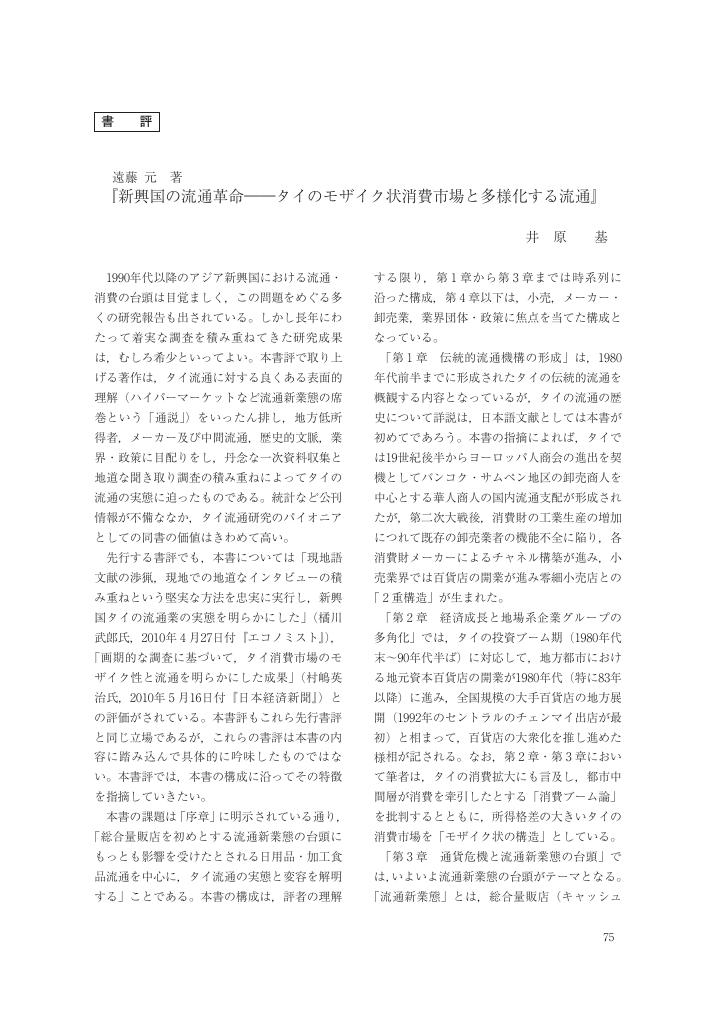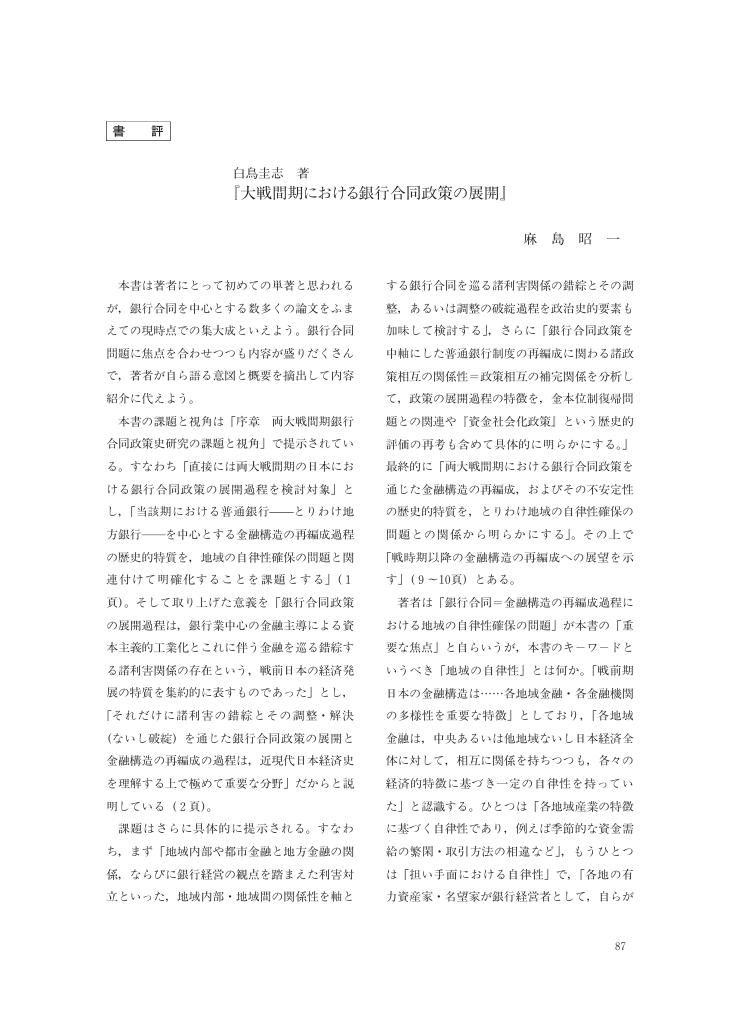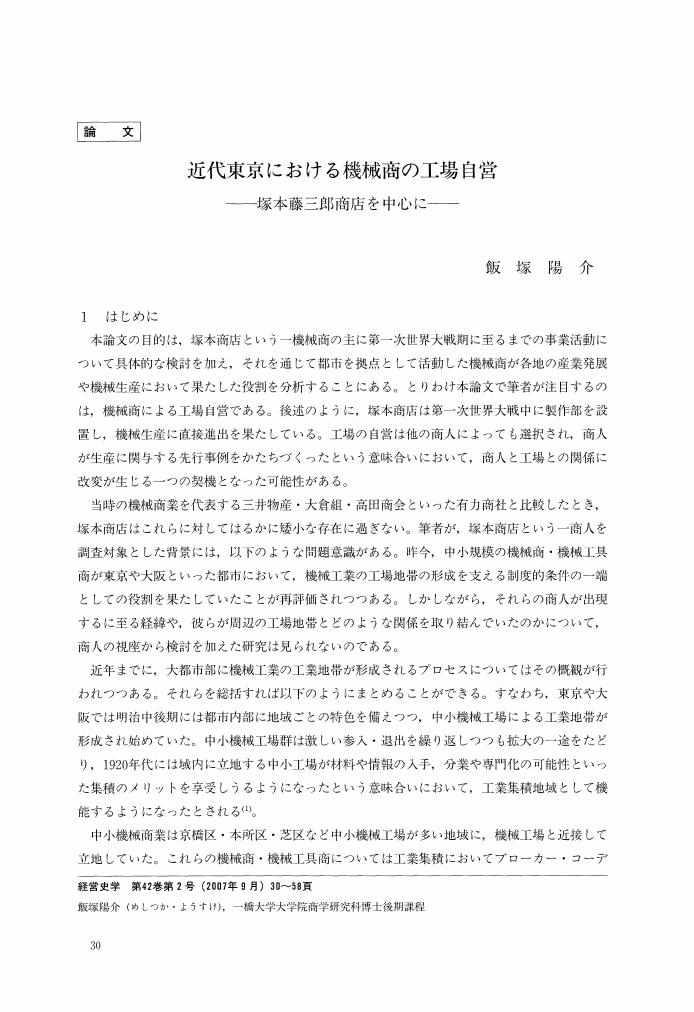1 0 0 0 OA 明治後期における地方紡績企業の合併 ―一宮紡績株式会社を事例として―
- 著者
- 橋口 勝利
- 出版者
- 経営史学会
- 雑誌
- 経営史学 (ISSN:03869113)
- 巻号頁・発行日
- vol.47, no.4, pp.4_3-4_24, 2013 (Released:2016-01-27)
This paper aims to examine the factors of the merger between the local cotton-spinning companies in the late Meiji era.Ichinomiya Spinning Company was founded in 1895 by local and Nagoya wealthy persons, and produced gas-thread as its core product. However, its business activity deteriorated because of the depression after the Russo-Japanese War, so Ichinomiya Spinning Company came to depend the debt much more than before. As a result, a large amount of the stocks of Ichinomiya Spinning Company were sold by major stockholders who lived outside the Ichinomiya area.Since the Meiji government recommended the business combination, Masaka Okuda, who was the then president of Owari Spinning Company, formed Bisei-Rengo which was composed of the cotton spinning companies in the Chukyo area, and promoted the mergers. Okuda negotiated with Shinichiro Saburi, who was the then president of Ichinomiya Spinning Company, about the merger plan, and Saburi decided to merge with Mie Spinning Company. At the same time, Mie Spinning Company tried to acquire Chita Spinning Company.However, the merger terms for Ichinomiya Spinning Company were inferior to those for Chita Spinning Company. Therefore, the stockholders of Ichinomiya Spinning Company fiercely opposed to merge with Mie Spinning Company. In the end, the merger negotiations between Ichinomiya Spinning Company and Mie Spinning Company broke down, and Ichinomiya Spinning Company merged with Nihon Spinning Company.In short, the stockholders' will of the merged company played an important role in the merger negotiations between spinning companies. In addition, the corporate merger between Ichinomiya Spinning Company and Nihon Spinning Company helped to control the capital concentration on the big spinning companies and to intensify the competition among spinning companies.
- 著者
- 杉山 裕
- 出版者
- 経営史学会
- 雑誌
- 経営史学 (ISSN:03869113)
- 巻号頁・発行日
- vol.47, no.4, pp.4_25-4_49, 2013 (Released:2016-01-27)
The purpose of this paper is to investigate the relationship between blue-collar workers' personnel management systems and workplace management in the high growth era. We deal with the case of major steel companies as an example, especially Yawata Steel and Nippon Steel that had strongly impacted on labor management in Japan.Previous studies explain that the competitiveness of Japanese firms, especially prior to the “bubble economy”, was based on high “workplace level” skills, i.e., high blue-collar worker skill levels. They make much of competency-based pay (noryoku-kyu) and the ability-based grading system (shokuno-shikaku-seido) because they effectively encouraged employee skill development. Prior research states that these systems had been introduced in the latter half of 1960's. In contrast, the introduction of job-based wages (shokumu-kyu) using job analysis and job evaluation, adopted by the 1960s and called “American-style management” by researchers, has been regarded as a failure because it did not match Japanese workers' values and did not raise worker ability levels. Recently, however, some articles point out that job-based workplace management played an important role in rationalizing workplaces. So we would need to integrate our understanding of the two views.The content of this paper is as follows. Until the 1960's, shopfloor workers could not take on the responsibility of process control because of their low abilities and weak work consciousness. At the same time, it was difficult for managers to carry out efficient shopfloor management because they did not understand actual work conditions. In this situation, job analysis and job evaluation furnished administrators with the methods of rationalization and personnel management. In the mid-1970's, blue-collar workers came to acquire highlevel skills, such as industrial engineering, so they played an important role in supervising shopfloor work. In conclusion, managers of the two companies chose sound strategies. We should acknowledge the strength of their business judgment from a contemporary perspective.
1 0 0 0 OA 地方の企業勃興とその担い手 ―福岡県を事例として―
- 著者
- 草野 真樹
- 出版者
- 経営史学会
- 雑誌
- 経営史学 (ISSN:03869113)
- 巻号頁・発行日
- vol.47, no.1, pp.1_3-1_25, 2012 (Released:2016-01-27)
In this paper, I considered the features of the enterprise boom in local area and its carrier focused on the case in Fukuoka prefecture. Considerations in this paper includes only corporations and the period is by 1899. The facts clarified by the considerations in this paper are briefly mentioned as follows.In Fukuoka prefecture, first of all, it started from establishments of financial companies. In the late 1880s, industrial infrastructure, such as railway companies or harbour construction companies, and spinning companies were risen. After the mid of 1890s, number of establishments of companies were increasing and it didn't occurred only in limited area, but also did at several areas. Number of establishment of companies from 1893 to 1899 reached 196 and it peaked in 1897.Seeing the details of the number of companies regarding to their categories, the highest was 86 in banking business, followed by 54 in manufacturing industry, 39 in commerce, 8 in transportation business, 6 in mining industry, 3 fisheries. The capital of railway business, as transportation, was prominantly large. However, 153 companies, 78.1% of 196 of them in total, were medium and small enterprises whose capital was not more than 100,000 yen.Number of directors at 196 companies mentioned above was 929 in total and 744 at actual number. Most of them were local wealth holders in Fukuoka prefecture and to possess a certain amount of wealth was important factor to form entrepreneurs. Considering the relations between establishment of companies and origins of entrepreneurs, landowners were enthusiastic to found banks and local merchants were enthusiastic to set up companies had wide varieties.
1 0 0 0 OA 高度成長期自動車産業における下請取引 ―東洋工業を事例に―
- 著者
- 菊池 航
- 出版者
- 経営史学会
- 雑誌
- 経営史学 (ISSN:03869113)
- 巻号頁・発行日
- vol.47, no.1, pp.1_26-1_48, 2012 (Released:2016-01-27)
The purpose of this paper is to clarify the features of subcontracting in the automobile industry during the high growth period, using Toyo Kogyo as an example. Toyo Kogyo reallocated its management resources from three-wheeled to four-wheeled vehicles in the era of high growth, and was number three in production of four-wheeled vehicles after 1960.From the late 1950s to the early 1960s, Toyo Kogyo expanded its use of subcontractors. The subcontractors were small firms located in Hiroshima. They had high sales dependence on Toyo Kogyo, and performed processing after receiving drawings and materials from Toyo Kogyo. In the process of expanding its use of subcontractors, Toyo Kogyo developed a department to manage subcontractors, and built an institution for adjusting order quantities to suit the management efforts of subcontractors. In addition, in transactions between Toyo Kogyo and its subcontractors, the ownership of dies and tools reverted to Toyo Kogyo. Toyo Kogyo selected governance mechanisms to promote ex post competition.After 1960, the wage differentials between automobile manufacturers and subcontractors exhibited a sharply declining trend. This reduction in wage differentials was brought about by a relative increase in wages at small subcontractors. One cause of this payment of wages was the realization of efficient management at subcontractors. As indicated by Shinei Kogyo (treated in this paper), there were also subcontractors who booked a higher return on total assets than Toyo Kogyo because they increased total asset turnover by using machines efficiently. Part of the development of the Japanese automobile industry was achieved by the automobile manufacturers developing diverse institutions to inhibit opportunistic behavior, and suppliers deploying efficient management over a broad range.
1 0 0 0 OA 書評
- 出版者
- 経営史学会
- 雑誌
- 経営史学 (ISSN:03869113)
- 巻号頁・発行日
- vol.47, no.1, pp.1_75-1_93, 2012 (Released:2016-01-27)
1 0 0 0 OA 日露戦後の電球産業の成長
- 著者
- 菊池 慶彦
- 出版者
- 経営史学会
- 雑誌
- 経営史学 (ISSN:03869113)
- 巻号頁・発行日
- vol.47, no.2, pp.2_3-2_29, 2012 (Released:2016-01-27)
The aim of this paper is to analyze the development of the Japanese electric lamp industry after the Russo-Japanese war. Subsequent to the war, the Japanese electric power industry grew rapidly, and there was a substantial increase in the supply of electric lighting. In this robust market, the Japanese electric lamp industry gradually gained ascendency over imported lamps.In 1905, the Tokyo Electric Company entered into a capital and technical alliance with General Electric. Tokyo Electric as a subsidiary of GE attained the advantage in the Japanese market. Further, Tokyo Electric had a close connection with large customers and reliable information on the Japanese market. Conversely, GE had superior mass production technology. Owing to the combination of the above-mentioned strong points, Tokyo Electric expanded the supply of market-oriented quality products.Simultaneously, several manufacturers also entered the market. A number of these mature influential firms established close connections with large customers. The competition between Tokyo Electric and those influential firms facilitated the growth of the electric lamp industry.Meanwhile, the technical development of electric lamp was very rapid. In Europe and USA, several new types of lamps were developed. The most important product was the drawn-wire tungsten filament lamp, and it was developed by GE. As a result of the introduction of technology and supply of tungsten filament from GE, Tokyo Electric succeeded in manufacturing the new product.GE's strong patent gave Tokyo Electric a monopoly in the Japanese market. However, the coexistence of Tokyo Electric with several small-scale manufacturers continued. The increase in the supply of engineers and skilled laborers, the formation of related industry, and the close relationship and financial contribution with large customers facilitated entry and growth of small manufacturers. Moreover, several manufacturers attempted to open the retail market and export.
1 0 0 0 OA 木曽川の水力開発と電気製鉄製鋼事業 ―木曽電気製鉄から大同電力へ―
- 著者
- 浅野 伸一
- 出版者
- 経営史学会
- 雑誌
- 経営史学 (ISSN:03869113)
- 巻号頁・発行日
- vol.47, no.2, pp.2_30-2_48, 2012 (Released:2016-01-27)
Kiso Electric Iron & Steel Manufacture, which inherited water right and hydro-electric power stations of the Kiso River possessed by Nagoya Electric Light Company, was founded in the middle of the economic boom of the First World War, whose business purpose was manufacture of iron & steel using electric power and the wholesale of electric power. This company was the predecessor of today's Daido Steel Company and at the same time the predecessor of Daido Electric Power Company, which was one of the so-called “five great electric power company” in the 1930's and developed to today's Kansai Electric Power Company. I analyse the business, unifying manufacture of iron & steel using electric power and the wholesale of electric power, which has been treated as a separate business so far, then show the reason of foundation of Kiso Electric Iron & Steel Manufacture, which secured water right of the Kiso, and study why water right of the Kiso was separated from Nagoya Electric Light Company. I also demonstrate the transition of iron manufacture plant based upon the newly found material. Kiso Electric Iron & Steel Manufacture came to a dead-lock by the end of economic boom of the First World War, besides technical trouble and turned the wholesale of electric power as main business, and iron & steel manufacture as its side job, and finally Daido Electric Power Company being established. Through these analysis, I want to show the meaning of following issue at the electric power industry; ① the formation of nation-wide wholesale industry of electric power, ② the transformation of electric supply system in the Chubu Area, and ③ the development of management by Momosuke Fukuzawa, so-called “king of electric power”.
1 0 0 0 OA 書評
- 出版者
- 経営史学会
- 雑誌
- 経営史学 (ISSN:03869113)
- 巻号頁・発行日
- vol.43, no.1, pp.1_87-1_96, 2008 (Released:2011-10-18)
- 被引用文献数
- 1 1
1 0 0 0 OA 戦前戦時期松下の分社経営
- 著者
- 平本 厚
- 出版者
- 経営史学会
- 雑誌
- 経営史学 (ISSN:03869113)
- 巻号頁・発行日
- vol.42, no.4, pp.3-32, 2008-03-25 (Released:2010-05-18)
- 参考文献数
- 78
1 0 0 0 OA 鉄鋼業における職務給制度導入と人事労務管理の合理化 八幡製鉄を事例として
- 著者
- 杉山 裕
- 出版者
- 経営史学会
- 雑誌
- 経営史学 (ISSN:03869113)
- 巻号頁・発行日
- vol.42, no.4, pp.33-57, 2008-03-25 (Released:2010-05-18)
- 参考文献数
- 93
1 0 0 0 OA 地域経済活性化への経営史学の貢献
1 0 0 0 OA 国策会社の経営史 台湾拓殖における国策性と営利性
- 著者
- 久保 文克
- 出版者
- 経営史学会
- 雑誌
- 経営史学 (ISSN:03869113)
- 巻号頁・発行日
- vol.42, no.4, pp.68-74, 2008-03-25 (Released:2010-05-18)
1 0 0 0 OA 町 (街) おこし その展望と課題
- 著者
- 水口 和寿
- 出版者
- 経営史学会
- 雑誌
- 経営史学 (ISSN:03869113)
- 巻号頁・発行日
- vol.42, no.4, pp.74-80, 2008-03-25 (Released:2010-05-18)
1 0 0 0 OA 東アジア企業のグローバル競争力構造 競争力要因と競合・分業構造分析
- 著者
- 塩地 洋
- 出版者
- 経営史学会
- 雑誌
- 経営史学 (ISSN:03869113)
- 巻号頁・発行日
- vol.42, no.4, pp.80-86, 2008-03-25 (Released:2010-05-18)
1 0 0 0 OA 高度成長の展開と経営構造の変化 経営史からみた大衆消費社会の形成
- 著者
- 石井 晋
- 出版者
- 経営史学会
- 雑誌
- 経営史学 (ISSN:03869113)
- 巻号頁・発行日
- vol.42, no.4, pp.86-93, 2008-03-25 (Released:2010-05-18)
1 0 0 0 OA 地域再生と企業者活動
- 著者
- 井藤 正信
- 出版者
- 経営史学会
- 雑誌
- 経営史学 (ISSN:03869113)
- 巻号頁・発行日
- vol.42, no.4, pp.93-102, 2008-03-25 (Released:2010-05-18)
1 0 0 0 OA 近代東京における機械商の工場自営 -塚本藤三郎商店を中心に-
- 著者
- 飯塚 陽介
- 出版者
- 経営史学会
- 雑誌
- 経営史学 (ISSN:03869113)
- 巻号頁・発行日
- vol.42, no.2, pp.30-58, 2007-09-25 (Released:2010-03-19)
- 参考文献数
- 95
1 0 0 0 OA 戦後の日本企業の技術選択と技術発展 東洋紡績の合成繊維への進出を中心として
1 0 0 0 OA 明治前期製糸業における商標の確立と行政による保護 群馬県と福島県の制度分析と比較
- 著者
- 谷山 英祐
- 出版者
- 経営史学会
- 雑誌
- 経営史学 (ISSN:03869113)
- 巻号頁・発行日
- vol.42, no.3, pp.68-91, 2007-12-25 (Released:2010-03-19)
- 参考文献数
- 125
1 0 0 0 OA めざせ文化資源館! -渋沢栄一記念財団付属渋沢史料館, 実業史研究情報センターの新展開-
- 著者
- 井上 潤 小出 いずみ
- 出版者
- 経営史学会
- 雑誌
- 経営史学 (ISSN:03869113)
- 巻号頁・発行日
- vol.41, no.3, pp.57-65, 2006-12-25 (Released:2009-11-06)













